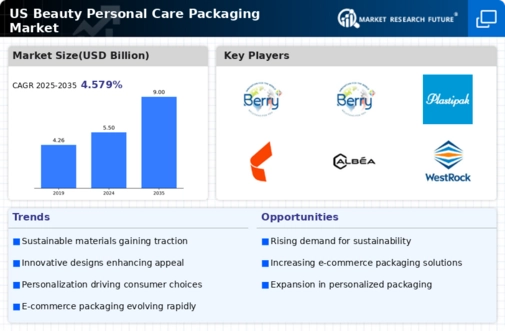Growth of E-Commerce and Online Retail
The beauty personal-care-packaging market is significantly influenced by the rapid growth of e-commerce and online retail channels. As of 2025, online sales of beauty products are projected to account for approximately 30% of total sales in the sector. This shift necessitates packaging that is not only visually appealing but also functional for shipping and handling. Brands are increasingly focusing on packaging designs that enhance the unboxing experience, which is crucial for online consumers. Moreover, the rise of subscription box services has further propelled the demand for innovative packaging solutions that cater to diverse product assortments. This trend indicates a transformation in consumer purchasing behavior, compelling brands to adapt their packaging strategies to thrive in the evolving beauty personal-care-packaging market.
Rising Demand for Eco-Friendly Materials
The beauty personal-care-packaging market is experiencing a notable shift towards eco-friendly materials, driven by increasing consumer awareness regarding environmental sustainability. As consumers become more conscious of their ecological footprint, brands are compelled to adopt sustainable packaging solutions. In 2025, it is estimated that over 60% of consumers in the US prefer products with recyclable or biodegradable packaging. This trend is not merely a passing phase; it reflects a broader societal movement towards sustainability. Consequently, manufacturers are investing in innovative materials such as plant-based plastics and recycled paper, which are gaining traction in the beauty personal-care-packaging market. This shift not only meets consumer demand but also aligns with regulatory pressures aimed at reducing plastic waste, thereby creating a more sustainable future for the industry.
Regulatory Compliance and Safety Standards
is shaped by stringent regulatory compliance and safety standards.. In the US, the Food and Drug Administration (FDA) and other regulatory bodies impose guidelines that govern packaging materials and labeling practices. As of 2025, brands must ensure that their packaging not only meets safety requirements but also provides clear information regarding ingredients and usage. This regulatory landscape compels manufacturers to invest in research and development to create packaging that adheres to these standards while maintaining aesthetic appeal. Furthermore, compliance with regulations can enhance consumer trust, as customers are more likely to purchase products that are transparently packaged. Thus, navigating the complexities of regulatory compliance is a critical driver for innovation in the beauty personal-care-packaging market.
Emergence of Customization and Personalization
is seeing a growing trend toward customization and personalization.. As consumers increasingly seek unique and tailored experiences, brands are responding by offering personalized packaging solutions. In 2025, it is projected that nearly 40% of consumers in the US are willing to pay a premium for customized packaging options. This trend is particularly evident in the rise of bespoke beauty products, where packaging is designed to reflect individual preferences and identities. Brands are leveraging technology to facilitate this customization, allowing consumers to choose colors, designs, and even messages on their packaging. This shift towards personalization not only enhances consumer engagement but also fosters brand loyalty, making it a pivotal driver in the evolving beauty personal-care-packaging market.
Influence of Social Media and Influencer Marketing
The beauty personal-care-packaging market is profoundly impacted by the rise of social media and influencer marketing. In 2025, it is estimated that over 70% of beauty consumers in the US are influenced by social media platforms when making purchasing decisions. This trend drives brands to create packaging that is not only functional but also visually striking, as aesthetically pleasing products are more likely to be shared online. The emphasis on 'Instagrammable' packaging has led to innovative designs that prioritize visual appeal, thereby enhancing brand visibility. Additionally, collaborations with influencers often result in limited-edition packaging that attracts consumer attention. This dynamic interplay between social media and packaging design is reshaping the beauty personal-care-packaging market, as brands strive to capture the attention of a digitally savvy audience.





















Leave a Comment